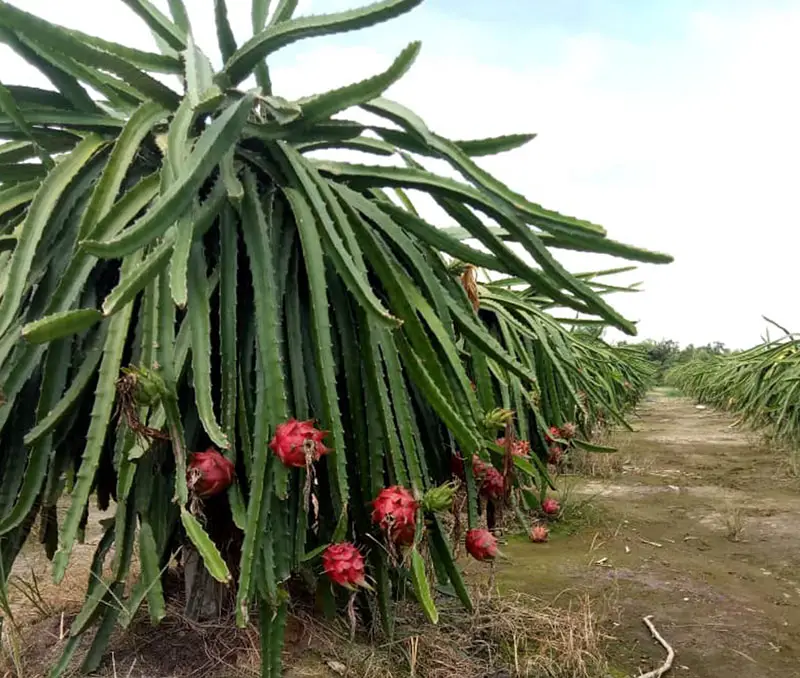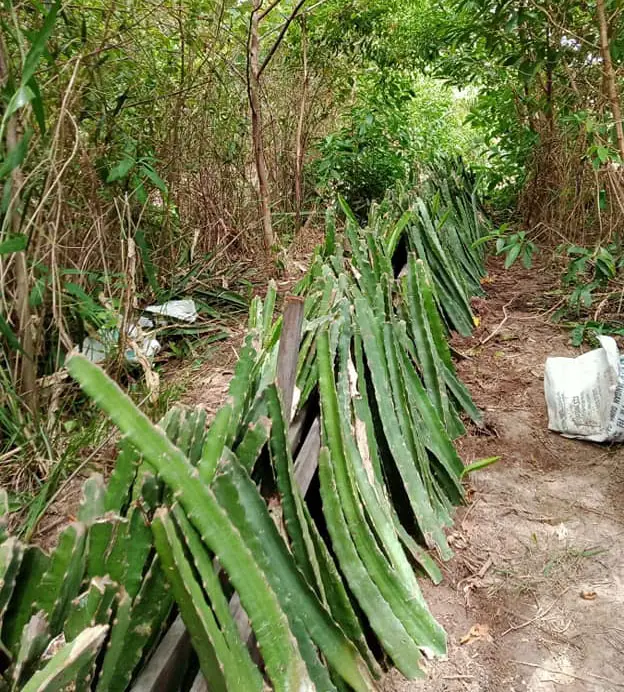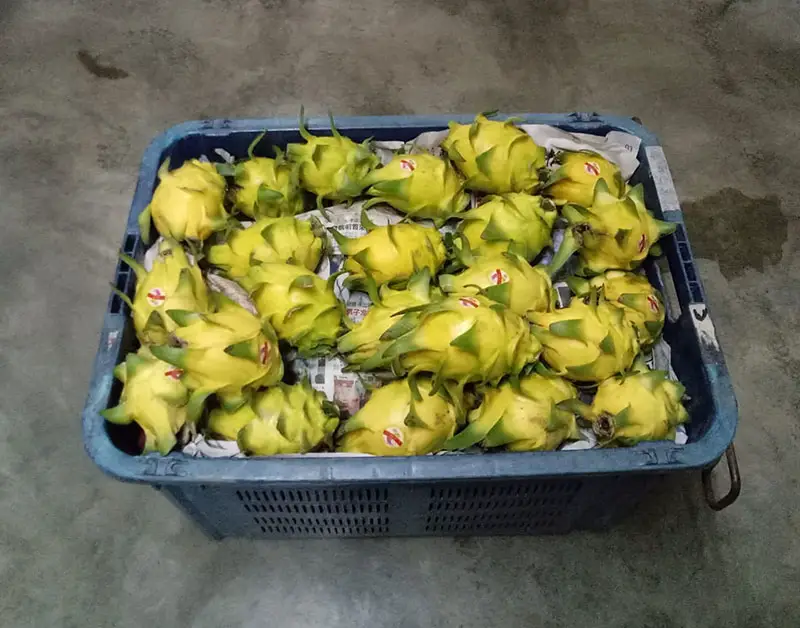Are you looking to add a unique and exotic touch to your garden? Dragon fruits are the perfect way to do just that. Their striking color and sweet flavor make them an eye-catching addition.
With just a little bit of work, you can get started growing these tasty treats right away. In this article, we’ll walk you through all the steps necessary to start and maintain a successful dragon fruit plantation – from selecting the right variety to common problems and solutions.
Selecting the Right Variety
When it comes to selecting the perfect variety for you, there’s a lot to consider – so make sure you do your research. Dragon fruit come in several varieties, including Hylocereus undatus (red flesh), Selenicereus megalanthus (yellow flesh), and Hylocereus costaricensis (pink flesh).
All three types have a sweet taste and are high in antioxidants. Depending on where you live, some varieties may be more suitable than others. For example, Hylocereus undatus is better suited to warm climates such as Mexico and Central America, while Selenicereus megalanthus is better suited for cooler climates like those found in the United States or Canada.
It’s also important to choose dragon fruit plants that are disease-resistant. To ensure that you get healthy plants, purchase them from reputable nurseries or growers’ markets. With this knowledge under your belt, you can confidently pick the right variety for your garden.
Preparing the Soil
Planting perfect produce requires preparing the proper plot. If you want to grow juicy, sweet dragon fruit and ensure your plants are healthy, it’s important to prepare the soil properly before planting.
Here’s how to do it:
1. Begin by testing the pH of your soil—you want a neutral pH level between 6 and 7 for dragon fruits to thrive.
2. Amend the soil with organic compost or manure to be light and full of nutrients. Ensure the amendment has been aged at least one year before use, as fresh material can burn plant roots.
3. Incorporate gravel into areas with poor drainage to promote better water absorption and help prevent root rot due to excess moisture staying in the ground too long.
Planting Dragon Fruits
Now that you’ve prepared your soil, it’s time to get your hands dirty and plant the dragon fruits of your dreams.
It is important to note that dragon fruit plants can be purchased as a seedling or pre-germinated in a pot. If buying a seedling, look for one with healthy leaves and no signs of disease.
Planting the seedling is quite simple: take the pot off the root system and place it in a hole about twice as wide as the root ball. The top of the rootball should be slightly above ground level when finished planting. Fill in with soil around the sides, pressing down gently but firmly to ensure the roots are securely planted.
Water thoroughly after planting.
Water and Fertilizer Requirements
You’ll need to keep a steady eye on your new tree’s hydration and nutrition needs, so it can thrive and blossom with vibrancy.
Watering dragon fruit trees is critical for their health; however, overwatering can be just as detrimental. Aim to water your plant deeply once or twice a week and more often in hotter climates. When the top inch of soil is dry, that’s when you should water your dragon fruit tree, making sure not to wet the leaves in order to prevent fungal diseases.
Fertilizing your luscious tree every 6 weeks during its growing season with an 8-3-9 fertilizer will ensure good growth and fruiting potential. Make sure to follow the instructions on the label for application rates as too much fertilizer can burn the roots of your dragon fruit tree.
Ensuring Adequate Sunlight
To get your new dragon fruit tree thriving, it’s important to make sure it gets plenty of sunlight for photosynthesis. Dragon fruits love lots of sun and are best grown in full sun. If you can’t provide at least 6 hours of direct sunlight daily, you may need to supplement with artificial lighting.
Here are some tips on how to ensure adequate sunlight for your dragon fruit plants:
- Maximize natural light by locating the plant near a south-facing window or patio door.
- Move your dragon fruit outdoors if possible during warmer months.
- Place reflective materials around the base of the plant to direct more light onto its leaves.
- Install LED grow lights or fluorescent bulbs if necessary indoors.
Providing enough sunlight is key for growing healthy dragon fruits. With regular monitoring, you can make sure that your plant is getting the right amount of light and maximize its growth potential.
Controlling Weeds and Pests
Keeping your dragon fruit tree free from weeds and pests is critical for its success, and you’ll need to be vigilant about it – even if it feels like an uphill battle at times.
A good way to start is by keeping the area around the tree clear of weeds and other plants. Pull any weeds that appear in the vicinity of the tree, as these can compete with your dragon fruit for nutrients in the soil. To prevent new weed growth, apply a pre-emergent herbicide a few weeks before planting or seeding.
Insects can also cause severe damage to your dragon fruit tree. Monitor your plant regularly for signs of infestation and act quickly if you find anything suspicious. Insecticides are available that are specifically formulated for use on dragon fruits; make sure you read all instructions carefully before applying them.
Make sure you also remove affected leaves or branches as soon as possible to limit the further spread of the pest population.
Training and Pruning Dragon Fruits
Now that your dragon fruit plant is growing and healthy, it’s time to get it trained and pruned. It’s essential for the health of the plant, as well as for its yield. Training and pruning are also important in order to help control pests and diseases. Pruning will help keep the dragon fruit vine contained within a limited space.
Training should begin when the dragon fruit vine reaches 6-10 feet tall. You can use stakes or trellises to train the vines up and away from other plants in your garden. This way, they’ll have plenty of room to grow while not taking over other parts of your garden.
Make sure you cut off any dead or diseased branches before you start training them so that they don’t spread their disease further into your garden.
Harvesting and Storing Dragon Fruits
Once you’ve trained and pruned your dragon fruit vines, it’s time to reap the rewards of your hard work – harvesting and storing these delicious fruits.
Harvesting dragon fruits is best done when they have a red color with some pinkish tinges. To pick a ripe dragon fruit, gently tug on the stem until it separates easily from the vine. Carefully cut away any brown spots or discoloration as this could indicate mold or rot.
If stored properly, dragon fruits can last up to two weeks in the refrigerator. It’s important to note that freshly picked dragon fruits are not always edible right away as they may need a few days to soften before eating them. You will know when you can eat them if their skin gives just slightly when you press on them.
You can also store harvested dragon fruits at room temperature for up to five days but make sure to keep them in an airtight container out of direct sunlight and humidity which can cause them to spoil quickly.
With that said, however, it’s best to consume the fruits within three days of harvesting for optimal flavor and texture.
Common Problems and Solutions
You can enjoy the bounty of your dragon fruits with ease by being aware of common issues and solutions related to their growth.
The most common issue is sunburn. Dragon fruits need to get at least 6 hours of direct sunlight a day, but too much can cause sunburn. To prevent this, make sure you provide partial shade or some sort of protection from direct sunlight during the hottest parts of the day.
Pests like ants, mealybugs, and scale insects may infest dragon fruits. You can use insecticidal soaps or neem oil to treat these pests with an organic solution.
The improper watering technique is another common problem that causes wilting leaves and fruit drops. Make sure you water deeply two to three times a week in summer until you see runoff coming out from the pot’s drainage holes; in winter reduce watering frequency to once per week or less depending on local temperatures and rainfall amounts.
Companion Planting for Dragon Fruits
By pairing dragon fruits with the right companion plants, you can make sure they thrive and create an even more vibrant garden.
Dragon fruit plants are sensitive to their environment, so it’s important to choose the right combination of companion plants for them. If you live in a hot and dry climate, consider planting ground cover with your dragon fruit plant. This will help keep soil temperatures cooler and reduce moisture loss from evaporation.
You can also pair dragon fruit with other cacti and succulents such as aloe vera or prickly pear. These drought-tolerant plants require little water and maintenance, making them ideal companions for your dragon fruit plant.
Some vegetables like tomatoes can be planted near dragon fruits as well; these larger plants provide shade during summer months when temperatures rise. Not only will this help protect your dragon fruit plant from sunburns, but tomatoes are also known to attract beneficial insects that can help pollinate the flowers on your dragon fruit plant.
Growing Dragon Fruits in Containers
Now that you know the companion plants to pair with dragon fruit, it’s time to talk about growing them in containers.
Container gardening is a great option for those who don’t have much outdoor space or want a less permanent planting area. Growing dragon fruits in containers is possible but require some extra attention as the container will hold less soil and may dry out quickly.
To grow dragon fruits in containers, you’ll need a pot at least 24 inches deep and 18 inches wide so your plant has plenty of room to grow.
Fill the pot with well-draining soil suitable for cacti and succulents, such as an amended mix of equal parts garden loam, coarse sand, peat moss, and perlite or vermiculite.
It’s also important to ensure your container has several drainage holes at the bottom so excess water can escape freely.
Growing Dragon Fruits from Cuttings
Propagating your own dragon fruit plant from cuttings is a rewarding experience, allowing you to watch it take root and blossom over time. To begin, use a sharp pair of scissors or a knife to cut off a stem with two or more leaves from an existing plant. Make sure the cutting has at least two nodes (the small bumps along the stem where new shoots will form).
Here’s what you need to do next:
- Place your cutting in water in order for the roots to start forming.
- Change out the water every three days until white roots have grown long enough that they can be planted into soil or potting mix.
- Once planted, make sure that your soil is kept moist but not soggy – too much moisture may cause rot and kill your cutting before it takes root properly.
- When new growth appears, provide adequate sunlight either outdoors or indoors – if growing indoors, make sure that temperatures range between 65-85°F (18-29°C).
Dragon fruits are relatively easy to grow from cuttings if you keep up with proper maintenance such as watering and pruning regularly as needed; that’ll help ensure healthy growth and increased yields each season.



